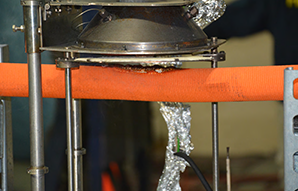Fire Fighter Fatality Investigation Prompts Fire Hose Performance Testing and Revised Standards
September 2017
DHHS (NIOSH) Publication Number 2017-205
A Story of Impact:

Personal protective equipment, such as fire fighter turnout gear, is vital in firefighting operations. Turnout gear offers thermal protection to keep fire fighters safe. Hoselines are also important protective equipment for fire crews entering burning buildings. However, hoselines have been damaged during recent firefighting operations.
Fires involving modern materials burn much faster than those of several decades ago, resulting in rapidly deteriorating fire conditions that can damage hoselines. While thermal protection for firefighter turnout gear and breathing apparatus have improved, thermal protection for fire hoses has remained unchanged. Although unchanged, there are existing testing requirements that fire hoses must meet.*
In 2014, a fire lieutenant and fire fighter died fighting a fire in a residential Brownstone. Their deaths were the result of a combination of factors, including: open doors that created an unrestricted flow path for the fire, strong winds that intensified the fire, and damage to the hoseline that prevented water flow.
The lieutenant and firefighter entered the building through the front door with a hose without water and moved downstairs to the basement, searching for the source of the fire and a potential victim. High winds impacted the intensity of the fire, allowing it to spread quickly. The lieutenant gave the order to charge the hoseline with water, but the extreme heat had burned it through preventing water flow. A back-up hoseline was also burned through. The lieutenant and fire fighter became trapped.
The NIOSH Fire Fighter Fatality Investigation and Prevention Program (FFFIPP), which conducts independent investigations of fire fighter line-of-duty deaths, observed the damaged hoseline during their investigation1 and were aware of it occurring in other incidents. To address this issue, the FFFIPP investigators contacted the Bureau of Alcohol, Tobacco, Firearms, and Explosives (ATF) in May 2014 for assistance.
NIOSH provided samples of commonly used hoses to ATF. ATF tested the hoses in controlled fires of actual townhomes to measure approximate heat and temperature exposure at the time of rupture. Testing then moved to a controlled environment at the ATF Fire Research Laboratory. There, tests replicated the heat exposure recorded in the townhouse testing and established a repeatable method to compare the performance of different hose types. Samples of hoses from 5 manufacturers were tested.2
In May 2016, ATF presented their findings to the National Fire Protection Association Technical Committee (NFPA) on Fire Hoses, and proposed new standards for thermal performance. These standards are expected in the next edition of NFPA 1961. In the interim, NFPA published a bulletin on the importance of adhering to current hose requirements.3
Beyond studying hose performance, Underwriters Laboratories (UL) and the UL Firefighter Safety Research Institute are working with manufacturers, NFPA, and NIOSH to study the thermal exposure conditions in house fires.4 Study findings will help in understanding thermal performance of fire fighter protective clothing and equipment, including hoses.
- ATF tested the impact of radiant heat on fire hoses to establish thermal performance tests.
- NFPA proposed a requirement for new thermal performance standards for fire hoses in the future edition of NFPA 1961.
- NFPA issued an attack fire hose safety bulletin in February 2017.
- UL and the UL Firefighter Safety Research Institute are studying the impact of thermal conditions on fire fighter gear, equipment, and hoses.
View/Download Entire Document: Fire Fighter Fatality Investigation Prompts Fire Hose Performance Testing and Revised Standards
![]()
![]()

![]()
*According to the National Fire Protection Association 1961, an attack fire hose must meet the testing requirements of ANSI/UL 19, Lined Fire Hose and Hose Assemblies, Heat-Resistance Test; FMClass Number 2111, Factory Mutual Approval Standard for Fire Hose, Heat Resistance Test; or equivalent.
Mention of company names or products does not imply endorsement by the National Institute for Occupational Safety and Health. Additionally, citations to websites external to NIOSH do not constitute NIOSH endorsement of the sponsoring organizations or their programs or products. Further, NIOSH is not responsible for the content of these websites. All web addresses referenced in this document were accessible as of the publication date.
For more information about the NIOSH Fire Fighter Fatality Investigation and Prevention Program, and to see a complete listing of our reports, visit: (https://www.cdc.gov/niosh/fire/).
References
- NIOSH [2014]. Lieutenant and fire fighter die and 13 fire fighters injured in a wind-driven fire in a brownstone—Massachusetts. By Loflin M, Miles S. Morgantown, WV: U.S. Department of Health and Human Services, Centers for Disease and Control Prevention, National Institute for Occupational Safety and Heath, F2014-09, https://stacks.cdc.gov/view/cdc/163407
- Herb LA, St. John A [2017]. Thermal failure of hoselines: An analysis of the data. Fire Engineering, April, http://www.fireengineering.com/articles/print/volume-170/issue-4/features/thermal-failure-of-hoselines-an-analysis-of-the-data.html
- National Fire Protection Association [2017]. Bulletin: Attack Fire Hoses, http://www.nfpa.org/attackfirehose
- Madrzykowski, D [2017]. Fire fighter equipment operational environment (FFEOE): Evaluation of thermal conditions, http://www.nfpa.org/news-and-research/resources/fire-protection-research-foundation/current-projects/fire-fighter-equipment-operational-environment-evaluation-of-thermal-conditions
Suggested Citation
NIOSH [2017]. Fire Fighter Fatality Investigation Prompts Fire Hose Performance Testing and Revised Standards. By Bowyer M., Loflin M., Merinar T., Miles S., Moore P., Wertman S., and Webb S. Morgantown, WV: U.S. Department of Health and Human Services, Centers for Disease Control and Prevention, National Institute for Occupational Safety and Health, DHHS (NIOSH) Publication 2017–205.
